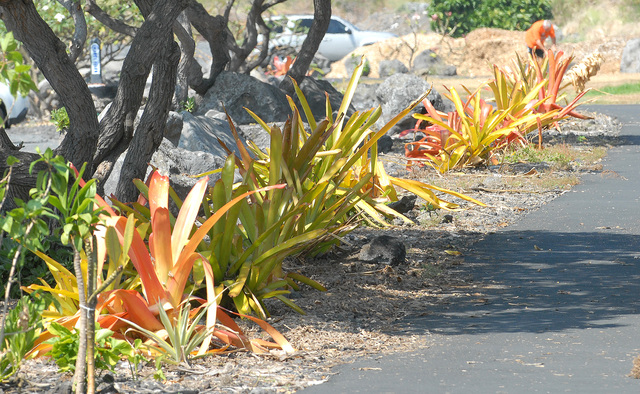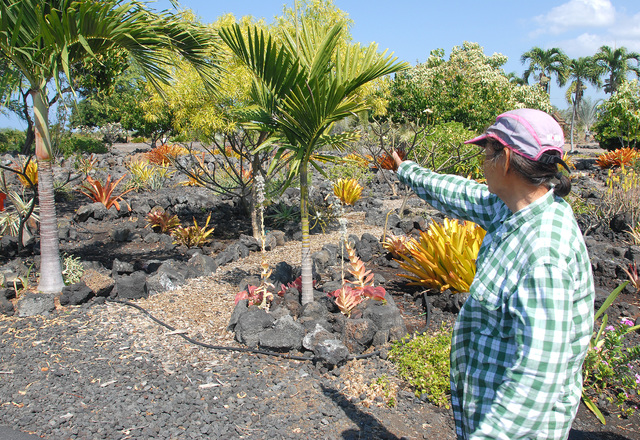KAILUA-KONA — Bromeliads growing in abundance along the Makaeo walking and jogging path have become a source of anxiety for at least a couple of volunteers who work to keep the park nice.
KAILUA-KONA — Bromeliads growing in abundance along the Makaeo walking and jogging path have become a source of anxiety for at least a couple of volunteers who work to keep the park nice.
Many of the plants were put in the ground years ago, but other have been propagated just recently, making Denise Trunk wonder why more isn’t being done to discourage the plantings and treat the mosquito-breeding water that the bromeliads hold near their base.
“They hold two gallons,” she said. “They’re called nature’s watering tanks. My concern is we need to get a grip on things. The county can’t afford to pull these out and their workers can’t afford to get dengue.”
Ed Cochran, another volunteer in the park, is also worried about the potential breeding ground for the dengue virus. In the past, people have dropped off boxes of bromeliads at the park, and volunteers stick them in the ground, he said.
“A couple of months ago I came down here and there were eight to 10 boxes sitting here, and none of this was planted,” he said, gesturing to a stretch of bromeliads along the edge of a parking area at the north end of the park.
Friends For Fitness oversees the walking and jogging area and delegates some of its care to the various individuals and organizations that are interested in helping with stewardship. Betty DeRoy, who heads up that group, said concerns are being overblown.
Friends For Fitness has made it known it is discouraging further spreading the bromeliads, DeRoy said. Additionally, the group contacted the Hawaii County Department of Parks and Recreation about 10 days ago asking if the bromeliads should be pulled out.
“They said they have granules and soap and are taking care of it,” she said.
The department has already cut low branches to reduce breeding areas, she said.
“From being down there, I don’t think there’s a mosquito problem,” DeRoy said.
The parks department takes its direction from Civil Defense and the state Department of Health for spraying in parks, said parks spokesman Jason Armstrong.
“When they identify a park they feel needs to be sprayed, we get right on it,” Armstrong said. “So far, they haven’t told us spraying needs to occur at Makaeo.”
One of the volunteers who worked in the park contracted dengue, but it’s not clear where she got it from, Trunk said. Her own granddaughter got dengue on a visit to the island from Nevada in December, although that case was not connected to the park. A hula halau with which Trunk is associated uses the grassy area at the north end for practice, and she said she is concerned about dengue, especially for the child dancers.
The state “Fight the Bite” campaign specifically addresses bromeliads as breeding sites and urges the treatment of those plants and others that hold water. On Thursday, Bruce Anderson, who headed the state Department of Health during the Maui dengue outbreak of 2001, urged more attention to the elimination of breeding sites on this island. Anderson now serves as administrator of the state Division of Aquatic Resources.
Christina Garcia puts in many hours to keep the various plants and trees thriving at Makaeo, and said she can’t imagine the place without bromeliads.
She propagated five new plants last week, but doesn’t plan to spread any more. Garcia said she had noticed mosquitoes only in one shady area of a bromeliad patch at the south end.
“I’m not going to take them out,” she said. “What would the park look like with no bromeliads?”




